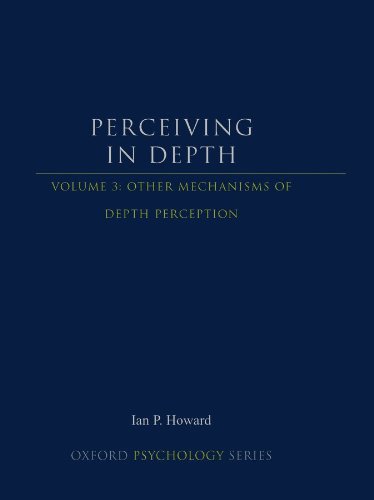Perceiving in Depth, Volume 3: Other Mechanisms of Depth Perception (Oxford Psychology Series) / Ian P. Howard
| List Price: | |
Our Price: $235.00 | |
|
For Bulk orders
| |
|
Used Book Price: $25.74 | |
| Perceiving in Depth, Volume 3: Other Mechanisms of Depth Perception (Oxford Psychology Series) / Ian P. Howard | |
| Publisher: Oxford University Press | |
| Availability:Temporarily out of stock. Order now and we'll deliver when available. We'll e-mail you with an estimated delivery date as soon as we have more information. Your credit card will not be charged until we ship the item. | |
| Sales Rank: 238578 | |
|
Similar Books
| Perceiving in Depth, Volume 1: Basic Mechanisms (Oxford Psychology Series) |
| Perceiving in Depth, Volume 2: Stereoscopic Vision (Oxford Psychology Series) |
The three-volume work Perceiving in Depth is a sequel to Binocular Vision and Stereopsis and to Seeing in Depth, both by Ian P. Howard and Brian J. Rogers. This work is much broader in scope than the previous books and includes mechanisms of depth perception by all senses, including aural, electrosensory organs, and the somatosensory system. Volume 1 reviews sensory coding, psychophysical and analytic procedures, and basic visual mechanisms. Volume 2 reviews stereoscopic vision. Volume 3 reviews all mechanisms of depth perception other than stereoscopic vision. The three volumes are extensively illustrated and referenced and provide the most detailed review of all aspects of perceiving the three-dimensional world.
Volume 3 addresses all depth-perception mechanisms other than stereopsis. The book starts with an account of monocular cues to depth, including accommodation, vergence eye movements, perspective, interposition, shading, and motion parallax. A chapter on constancies in depth perception, such as the ability to perceive the sizes and shapes of objects as they move or rotate in depth, is followed by a chapter on the ways in which depth cues interact. The next chapter reviews sources of information, such as changing disparity, image looming, and vergence eye movements, used in the perception of objects moving in depth. Various pathologies of depth perception, including visual neglect, stereoanomalies, and albanism are reviewed. Visual depth-perception mechanisms through the animal kingdom are described, starting with insects and progressing through crustaceans, fish, amphibians, reptiles, birds, and mammals. The chapter includes a discussion of how stereoscopic vision may have evolved. The next chapter describes how visual depth perception is used to guide reaching movements of the hand, avoiding obstacles, and walking to a distant object. The next three chapters review non-visual mechanisms of depth perception. Auditory mechanisms include auditory localization, echolocation in bats and marine mammals, and the lateral-line system of fish. Some fish emit electric discharges and then use electric sense organs to detect distortions of the electric field produced by nearby objects. Some beetles and snakes use heat-sensitive sense organs to detect sources of heat. The volume ends with a discussion of mechanisms used by animals to navigate to a distant site. Ants find their way back to the nest by using landmarks and by integrating their walking movements. Several animals navigate by the stars or by polarized sunlight. It seems that animals in several phyla navigate by detecting the Earth's magnetic field.
Now you can buy Books online in USA,UK, India and more than 100 countries.
*Terms and Conditions apply
Disclaimer: All product data on this page belongs to .
.
No guarantees are made as to accuracy of prices and information.
Volume 3 addresses all depth-perception mechanisms other than stereopsis. The book starts with an account of monocular cues to depth, including accommodation, vergence eye movements, perspective, interposition, shading, and motion parallax. A chapter on constancies in depth perception, such as the ability to perceive the sizes and shapes of objects as they move or rotate in depth, is followed by a chapter on the ways in which depth cues interact. The next chapter reviews sources of information, such as changing disparity, image looming, and vergence eye movements, used in the perception of objects moving in depth. Various pathologies of depth perception, including visual neglect, stereoanomalies, and albanism are reviewed. Visual depth-perception mechanisms through the animal kingdom are described, starting with insects and progressing through crustaceans, fish, amphibians, reptiles, birds, and mammals. The chapter includes a discussion of how stereoscopic vision may have evolved. The next chapter describes how visual depth perception is used to guide reaching movements of the hand, avoiding obstacles, and walking to a distant object. The next three chapters review non-visual mechanisms of depth perception. Auditory mechanisms include auditory localization, echolocation in bats and marine mammals, and the lateral-line system of fish. Some fish emit electric discharges and then use electric sense organs to detect distortions of the electric field produced by nearby objects. Some beetles and snakes use heat-sensitive sense organs to detect sources of heat. The volume ends with a discussion of mechanisms used by animals to navigate to a distant site. Ants find their way back to the nest by using landmarks and by integrating their walking movements. Several animals navigate by the stars or by polarized sunlight. It seems that animals in several phyla navigate by detecting the Earth's magnetic field.
Now you can buy Books online in USA,UK, India and more than 100 countries.
*Terms and Conditions apply
Disclaimer: All product data on this page belongs to
 .
.No guarantees are made as to accuracy of prices and information.










